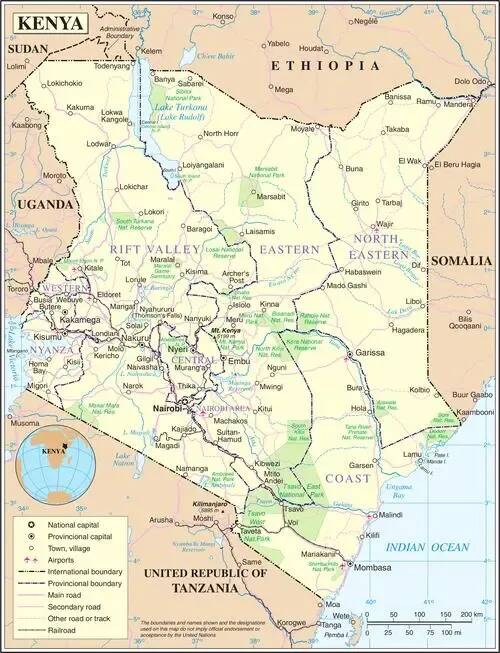Kenya| Introduction to Kirin Jaka, a coffee producing area
African coffee is well known in the global coffee market because the African country Ethiopia is recognized as the birthplace of coffee, and there are many excellent coffee producing countries, such as Ethiopia's neighbor Kenya.

Although Kenya is adjacent to Ethiopia, the birthplace of coffee, the coffee industry in Kenya is relatively late. It was first brought into Kenya by French missionaries from the island of Reunion in the 19th century and developed well. Up to now, Kenyan coffee is famous for its multi-level taste and juice-like acidity, and is loved by many people in the coffee industry.
Kenya is located in eastern Africa, is a country crossed by the equator, except for the coastal areas of the Wei Plain, most of the rest is a plateau with an average elevation of 1500 meters. On the other hand, the eastern branch of the East African Rift Valley cuts longitudinally into the north and south of the plateau, dividing the highland into eastern and western parts. There are also many volcanoes in Kenya, of which Mount Kenya, the extinct volcano in the central highlands, is 5199 meters above sea level, making it the second highest mountain in Africa.

Kenya is located in the tropical monsoon region, so most areas have a savanna climate, the coastal areas are humid and hot, and the plateau climate is mild. The rainy season is from March to June and October to December, and the annual temperature is between 12 and 24 ℃. High-altitude mountains, volcanic soil, plenty of sunshine and appropriate rainfall make the country's agriculture and tourism more developed.
Mount Kenya, which covers an area of 142000 hectares and ranges from 1600 to 5199 meters above sea level, became a United Nations protected area in 1978, so it is rich in natural resources.
In recent years, the Kirin Yaga (Kirinyaga, also known as Kirinya) producing area, located in central Kenya, near the high-altitude Mount Kenya, has gradually come into view. Coffee is grown at an altitude of 1300-1900 meters above sea level. With fertile volcanic soil, abundant Rain Water and cool climate, coffee is famous for its strong taste, rich layers and solid taste, and the Nyeri producing area is recognized as the two best producing areas in Kenya.
It is understood that the local Kikuyu call Mount Kenya Kirinyaga or Kere-Nyaga (the local language means White Mountain), and the local area has always respected this mountain as the home of their Almighty Voice Ngai.
Most of the producers in the Kirinyaga producing area are small coffee farmers who join the cooperative, while the cooperative provides washing plants, and coffee farmers send coffee cherries to the cooperative's processing plant for raw bean processing.
In order to taste the coffee flavor of the producing area, we got a washed Kirin Yajia BlackBerry queen's coffee beans and roasted them in medium and shallow.
After the baking is finished, the cup is tested in Qianjie, showing the aroma of berries and elegant purple flowers when it is dry, and the aroma of plum and lemon when injected with hot water. After the entrance, there can be bright purple fruit acidity, with plum, lemon, berry, plum flavor, slightly sweet, taste as soft as black tea.
Important Notice :
前街咖啡 FrontStreet Coffee has moved to new addredd:
FrontStreet Coffee Address: 315,Donghua East Road,GuangZhou
Tel:020 38364473
- Prev

What does the ratio of powder to water in coffee mean? What does the technical term for fine coffee mean by powder-to-liquid ratio?
The ratio of powder to water and the ratio of powder to liquid are different units of measurement used in coffee making. Because the names are very similar, it is easy for many novice friends to confuse them, which in turn causes deviations in the taste of the extracted coffee. So, Qianjie will share again today the difference between powder-liquid ratio and powder-water ratio. let us first talk about
- Next

Brazilian coffee production falls short of expectations! Robusta prices will rise
In recent times, Brazil's coffee producing areas are still affected by the El Niño phenomenon and have been in relatively dry weather, which is conducive to local coffee harvesting. However, according to the Safras&Mercado report, harvesting work is currently accelerating, and as of June 25, Brazil has already harvested.
Related
- Why can American refills for free? The difference between Americano and American drip pot coffee
- Being chased out of the rain in front of Starbucks?! Store: Sheltering from rain under umbrellas poses a safety hazard
- The white moonlight has changed?! Lucky launches "Big Winter Pear American"
- Hand-brewed coffee three-stage method, high-sweet and universal brewing method to share! What does the high sweet water level of hand-brewed coffee mean?
- What is the difference between raw, refined and full espresso coffee? How to extract espresso and taste good?
- A complete list of coffee bean names and their meanings! What is Yejia Shefi coffee? Where is Mantelin coffee?
- What grade does Arida Manor Kaduai coffee beans belong to? What treatment is Arida ASD slow anaerobic sun exposure?
- The milk tea cup becomes smaller?! Overlord Tea Girl launches a new "Return to Yunnan" series
- Accused of selling counterfeit and high-priced coffee beans! Well-known boutique coffee brand "Oukelao" bowed and apologized!
- How to make espresso dumplings? Can I eat coffee and glutinous rice balls together?

